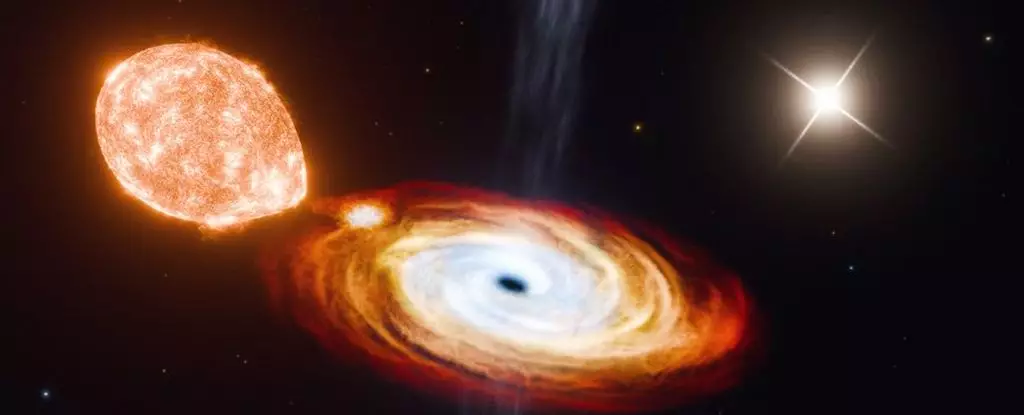In the depths of the constellation Cygnus, a remarkable celestial phenomenon challenges our understanding of black hole formation. The astronomical system known as V404 Cygni, located approximately 7,800 light-years from Earth, has recently unveiled an unexpected twist in its narrative. This discovery, which introduces a previously undetected third body—a star with a vast orbit of around 70,000 years—marks the first known trinary system featuring a black hole. Such a find not only excites scientists but also raises profound questions about the mechanisms driving black hole evolution.
V404 Cygni consists of a black hole and a companion star that orbits closely, completing a cycle every 6.5 days. This interaction creates a captivating spectacle as the black hole siphons material from its companion, illuminating the dynamic relationship between celestial bodies. The newfound companion star, streaming through space alongside the black hole, complicates the picture further and prompts us to reconsider established theories of black hole genesis.
Traditionally, scientists have relied on the supernova explosion model to explain black hole formation. This theory suggests that when a massive star reaches the end of its life, it undergoes an explosive death, shedding its outer layers while the core collapses into a black hole. However, the existence of a distant companion star challenges this narrative, suggesting that other formation processes may need to be taken into account.
Recent advances in astronomical mapping, spearheaded by the European Space Agency’s Gaia mission, brought to light the intricate dynamics of V404 Cygni. Gaia’s capacity to track not only position but also the trajectory and velocity of various celestial bodies revealed a connection between the black hole and its companion star. Both stars align in motion, indicating a gravitational bond that was not entirely understood until now. As Kevin Burdge from the Massachusetts Institute of Technology states, “It’s almost certainly not a coincidence or accident,” illustrating the necessity of redefining our assumptions about the system.
The realization that V404 Cygni is a trinary system opens avenues of inquiry into the evolutionary routes through which black holes can evolve. It allows scientists to ponder whether wide or distant companions can influence black hole formation in ways previously unconsidered.
As scientists investigate potential formation mechanisms, they navigate a labyrinth of theories regarding how black holes come into existence. While supernovae are widely acknowledged as a source of black holes, the discovery of V404 Cygni prompts discussions about direct collapse models. This alternative hypothesis posits that some massive stars may collapse directly without the spectacular explosions typically associated with supernovae.
A compelling argument arises from the physical characteristics of V404 Cygni. Given the extensive distance of 3,500 astronomical units separating the newly discovered star from the black hole, one would expect the gravitational connection to weaken significantly if a supernova had occurred nearby. Statistical simulations conducted by Burdge and colleagues lean towards the theory that the three objects were gravitationally bound prior to the black hole’s formation, lending credence to the direct collapse model.
The Broader Implications for Black Hole Research
The implications of this research extend beyond V404 Cygni alone. If the direct collapse model were validated, it would reshape our understanding of black hole evolution and the binary systems surrounding them. Kareem El-Badry of Caltech highlights the significance of this discovery, pondering whether such systems are rare or more common than previously thought. The existence of multiple black hole-inclusive trinary systems could unveil new insights into the formation pathways of black holes, challenging our existing conceptions of stellar life cycles.
The journey toward understanding these enigmatic celestial objects is far from over. The delicate interplay of forces within trinary systems such as V404 Cygni inevitably adds layers of complexity to their formation history. Unraveling these intricacies not only enriches our knowledge of black holes but may also serve to illuminate dark corners of cosmic evolution.
The discovery within V404 Cygni encourages astrophysicists to think creatively and re-evaluate long-held beliefs about black hole formation. The cosmos is a tapestry woven with intricate relationships and processes, and the more we explore, the more astonishing revelations await us. V404 Cygni stands as a testament to the boundless mysteries of the universe, urging us to probe deeper into the cosmic enigma.


Leave a Reply